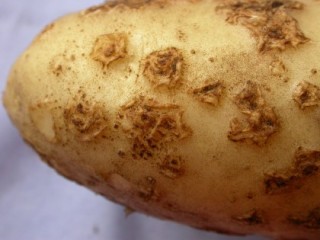
Tuber samples submitted for visual disease assessment are examined macroscopically (without magnification) for all common potato pathogens and any physical damage (resulting from pest or handling). The incidence (% of tubers affected) and severity (extent of surface infection on the tuber) of disease is recorded. Visual assessment identifies Skin Spot, Black Scurf, Silver Scurf, Black Dot, Dry Rot, Gangrene, Powdery Scab and Common Scab.
Where tubers are also submitted for microscopic examination, plugs of potato which include the eyes from seed tubers, are incubated and then examined under the microscope. This allows determination of incidence of fungi which may be present at low levels (and not apparent visually). This includes Skin Spot, Black Scurf, Silver Scurf and Black Dot.
NIAB recommends a sample size of 100 tubers for visual disease assessment. If customers have any bespoke requirements, discuss them with the team in advance by contacting Helen Appleyard.
For some diseases, further assessment may be needed. NIAB LabTest offers specific laboratory assays for the identification and quantification of Blackleg (Pectobacterium and Dickeya spp), identifcation of Tobacco Rattle Virus in tubers and soil and for identification of Powdery Scab and Common Scab with PCR-based confirmation.
